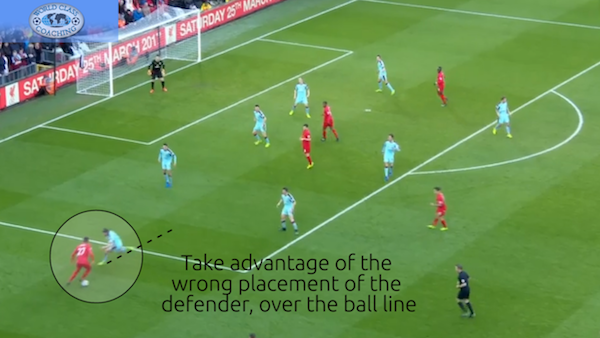WORLD CLASS COACHING
Scoring Goals from High Pressure Defending
By Luca Bertolini
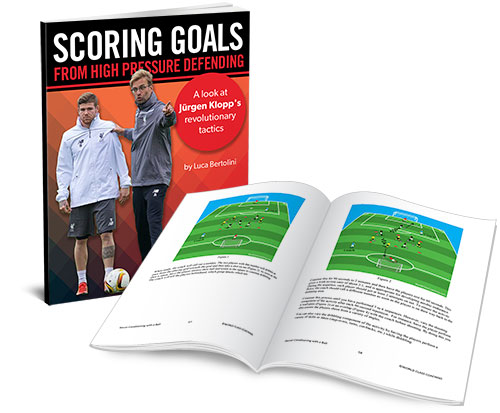
TABLE OF CONTENTS
Part One
INTRODUCTION
BUILD UP OF THE MOVES
Part Two
EXERCISE - 4V2 + GK
EXERCISE - 6V2 + GK
EXERCISE - 6V3 + GK
EXERCISE - 6V6 + GK SSG
Part Three
COUNTER ATTACKS
Part Four
EXERCISE - 6V4 + GK SSG
EXERCISE - 4V2 + GK SSG
INTRODUCTION
This e-book is based on all the goals scored by Jürgen Klopp’s Liverpool after the high pressure defensive phase, which took to build up the moves inside the opponent’s half field or to fast counterattacks; all these goals were scored during Premier League and FA Cup matches of the 2016/2017 season.
Klopp is one of the first coaches who started to play with high pressure defense tactic in Germany while working for Borussia Dortmund, seasons before Pep Guardiola coached Bayern Munich. He took the team on to win two National Championships (2010-2011 and 2011-2012) and to be the runner up of a Champions League final (2013). He developed the same style of play he used at FSV Mainz, bringing that club to the German first division for the first time, and to be a UEFA Cup qualifier during the 2005-2006 season.
The players are asked to play with maximum intensity and passion, always aggressively pressing their opposition, above all the players in possession, and always attempting to run their opposition off of the field, closing the pass lines or forcing wrong passes.
Klopp's usual formation on the field is the 1-4-2-3-1 and his teams prefer to attack with a technical counter when the opposition is open and exposed.
During the phases of play without the ball, his players try to limit the playing area of their opposition through a high defensive line, compressing their wingers and full backs into central areas. He prefers to put pressure against the opponents in their half to minimize the distance his team has to travel to get into scoring positions.
Blocking the center of the field is important for a successful positive transition phase, for a fast build up of the attacking play and for the counterattacks, if possible. The opponent with the ball is forced toward the direction of the touchline or back towards his own goal and away from the center of the field.
Another option is to run directly at the ball carrier. The opponent is pressed as aggressive as possible, to give him less time to think and to play in a right way to ensure his possession.
Another way to recover the ball is to run past the opponent first through a player who has no intention of winning the ball; he only must hand off the opponent and send him back toward his own original position. This way the opponent is forced into a specific action to which the pressing team can more easily react. A second player attacks the opponent directly and he can win the ball easier.
High pressure often means counter-pressing or "gegenpressing," if we call it in the German, since Guardiola coached Bayern Munich, after the loss of the possession of the ball. We may say that Klopp's Liverpool press tactics summarize all the main peculiar characteristics of the counter-pressing.
If the team tries to be "man-oriented,” above all in the final third, one player looks for an opponent to cover immediately after his team loses the ball (as we will see, the ball can be lost intentionally at a first stage, to overcome the opponent's pressure in the first third). A player runs up, cuts off the opponent, and forces him into a wrong action. Then all the near pass options are put under immediate pressure, so that the opponent cannot get free and escape the pressure.
A second option is the one Borussia Dortmund has used more than all the others under Jürgen Klopp: it is a "border-oriented," counter-pressing as the entire team plays in the direction of the ball and tries to generate the greatest pressure possible. This tactic induces errors, enables the team to cover and support the first pressing player, and closes all the nearby passing options, as it often causes the opponent to lose the ball soon or kick it long.
Sometimes the opponent is allowed to make the first pass, during a "lane-oriented" counter-pressing, even if under pressure of a player. The receiver is not attacked directly, but the pass itself, which should be wrongly directed at this point. This is the way Liverpool can build up the moves with positional or numerical advantage, exploiting the mistakes of the opponents.
The team can also run towards the ball without losing the structure of its formation; we will see that Liverpool plays this way when they can't put high pressure because of a long possession phase of the opponent, as the aim is always to defend forward and to be able to play directly toward the opposition's first third and penalty area.
When the possession of the ball is regained, they try to play the ball forward as quickly as possible; the first pass is always supposed to be toward the nearest player placed higher on the field.
As the developments of the moves and of all the goals are often the same, underlining the work of the coach behind them, and as they are independent of the opponents and of which player is in action, this e-book is focused on the situations and phases of play, rather than on a single player on the field.
If we summarize all the main goals of the high pressure, transitions, and defensive phases of Klopp's Liverpool, they are:
• To force the opponents to play toward a precise direction or long passes
• To mislead the opponent with the ball and take advantage of the mistakes
• To recover the possession inside the opponent’s half field
• To win the second time and the wandering balls
• To be able to play fast and vertically as the ball is recovered
• To be in positional or numerical advantage inside the final third
• To play fast counterattacks inside the spaces
• To directly attack the opponent’s goal after individual duels
• To play between the defenders and behind the defense line
• To finish even if outnumbered
This e-book is divided into two parts: the first one is about the fast build up of the moves when direct counterattacks are not possible and the second one is about fast counterattacks through the spaces among the defenders and behind the opponent's defense line.
At the end of each part and of the tactical analysis, some exercises are introduced to coach the players to fix any issue they may find inside the analyzed moves.
BUILD UP OF THE MOVES
If we would look for the general goals of the very high pressure of Klopp’s Liverpool inside the final third, they could be these: to recover the ball as soon as possible and to play fast as high on the field as possible.
The basic speed of the passes and of the combinations is a style of play that Liverpool never looses during the matches, even when the direct counterattacks are not possible and the moves must be finished through side by side play as build up phase.
This high pressure is useful to close the pass lines in the opponent’s first third, if the forward and the advanced midfielders are outnumbered against the opposition while the move is being built up, or to force long passes.
The main goal is to recover the possession high in the middle third, being in numerical advantage near the ball and to try to take advantage of the spaces between the midfield formation and the defense line of the opposition, while it's running up to the field after a long ball.

In this move we can see a numerical advantage near the ball after a long pass of the opposition (3 v 2) and an equal number of players during the following build up of a passes combination as positive transition phase.

Once the possession is ensured and the quick pass combinations to play forward are carried out, the rhythm is always accelerated to play forward and finish as fast as possible; the starting position on the field of the possession phase doesn't really matter.
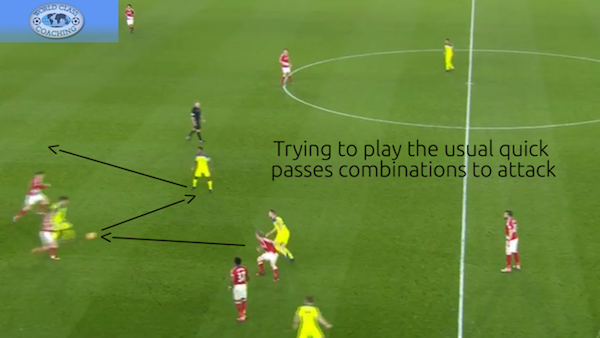
If there aren’t any available spaces, the rhythm of the combinations is slowed down, but not the basic speed of play of all the rest of the attacking players, which have to be always ready to receive unmarked or in positional advantage.
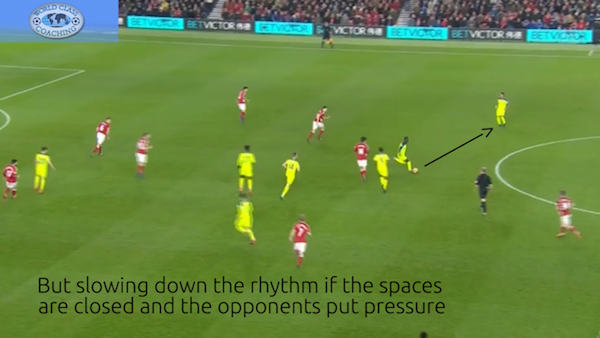
As they find the chance to play vertically, they come back to pass the ball among themselves with high rhythm to find the forwards in positional advantage. If the basic speed of play is not usually changed, the rhythm of the possession is often diversified to keep the possession against the counter-pressing of the opposition and to create new spaces to attack.
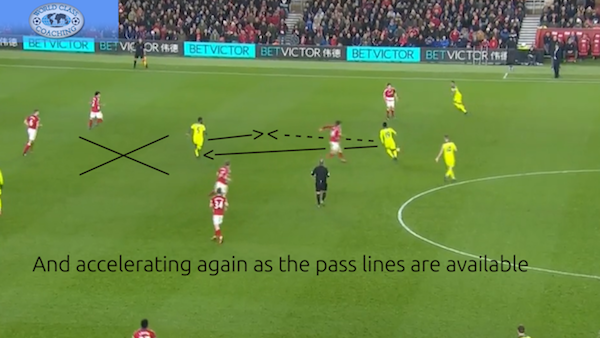
Once the move can be played in the final third and near the penalty area, decisive passes are sent behind the opposition defense line, to join the cutting runs of the advanced midfielders or of the center forward, if he didn't drop back to support the build up phase.
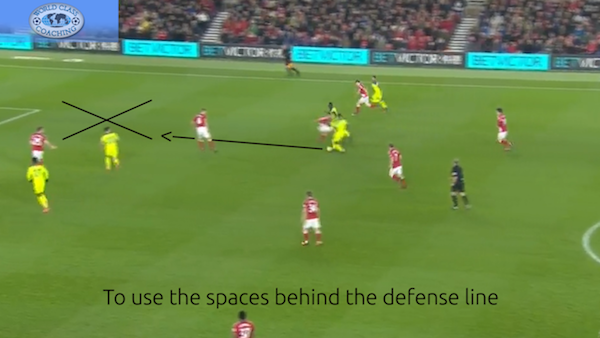
The positional advantages for the forwards to finish are a consequence of the accelerations and of the speed of play while in possession; the defenders are often on late and the advantages of the forward don't come from a counter movement to escape the mark, but from the space among the defenders.
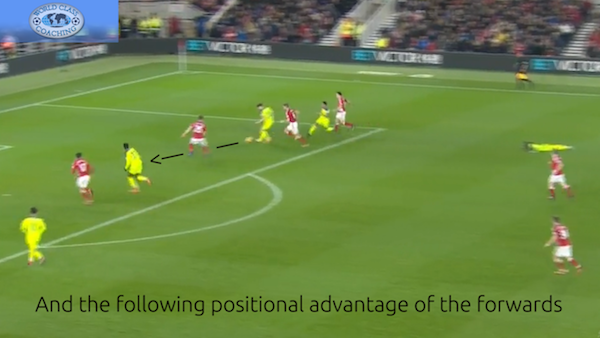
When the opponents try to build up the moves from the back (above all from the goalkeeper), the nearest player to the first receiver, usually the center forward, directs his dribble of the ball toward a precise direction and, if possible, toward a second teammate, who closes him directly or closes the pass lines. This way the center forward creates center spaces to be attacked by the three advanced midfielders, once the possession is regained.
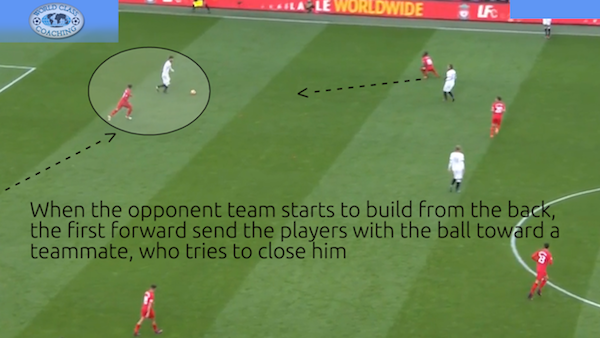
One of the center midfielders always runs out of his position in the middle against the receiver of an eventual first forward pass, attacking him when he controls the ball. This second receiver is supposed to lose possession or to be wrong in a pass.
In the usual 1-4-4-2 defense formation of Jürgen Klopp's teams, one of the two center midfielders is always more attacking-minded then the other one, who must keep the formation balanced together with the center backs.
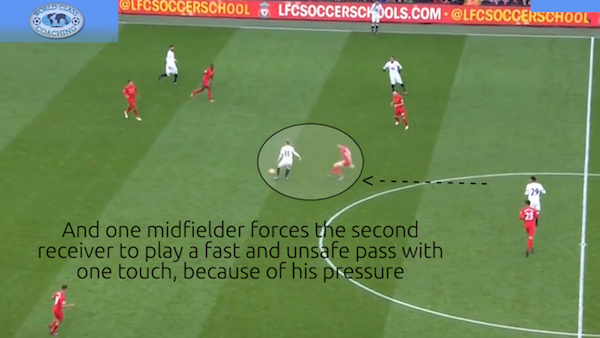
Fast positive transitions and pass combinations are now organized to play through the spaces among the opponents, while they are running up to the field. The center back and the full backs are placed high to support the move and to ensure the possession if it's not possible to play the first pass forward after the ball has been gained back.
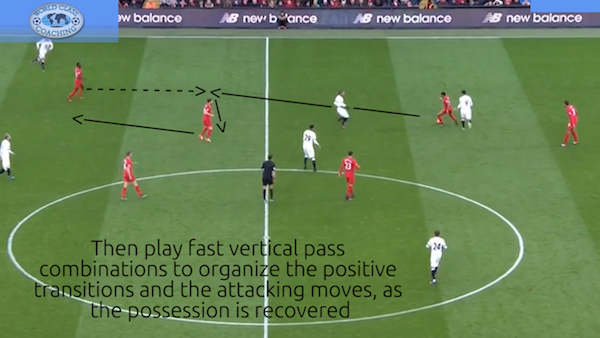
This is the reason why Liverpool can often finish against defenders on late in the final third, both through shots inside and outside the penalty area. In this situation the left advanced midfielder can finish even if outnumbered 1 v 2 (or even 1 v 4), shooting on goal, taking advantage of the space created by the center forward, who dropped back and of the space left by the defenders.
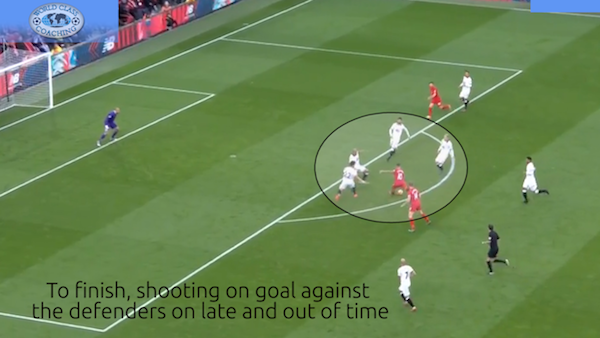
The counter-pressing tactic is used as the ball is lost inside the opposition half field, after long possession phases and if the whole team is placed high on the field. The closest player to the ball, the one who lost it, always puts pressure on the first opponent in possession.
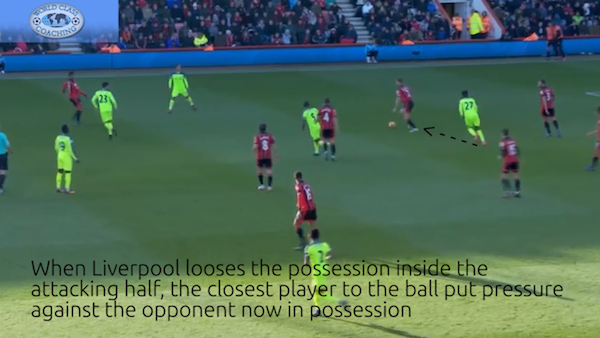
The main goals are two: to recover the possession against the opponent with the ball or to mislead him and to win the ball inside the middle third. In this move the mix of types of counter-pressing ways is very clear: attack the opponent with the ball, even if it's not possible to recover the possession directly, close the center and send him toward the side line misleading him to recover the ball.
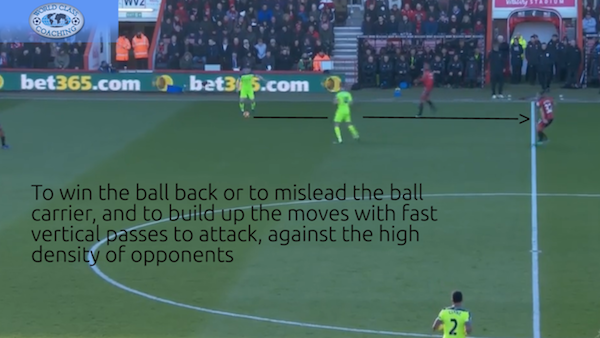
As Liverpool puts pressure in the middle third, there's a high density of players in this area; therefore long passes behind the defense lines toward a running teammate are then played to finish after an up and down fast pass combination.

This is another example of a mix of counter-pressing tactics: if Liverpool is in numerical advantage against and near a receiving opponent, as this 2/3 v 1 situation shows, all of them attack the opponent already before he can control the ball. The ball can be recovered directly or a back pass is forced, putting pressure even inside the penalty area, disturbing the long kick of the goalkeeper.

The direction of the passes is now forced and the second times of the balls can be won easily after eventual mistakes during the possession phase of the opponents. Again the strong pressure 2 v 1 against the receiver helps to recover the ball.
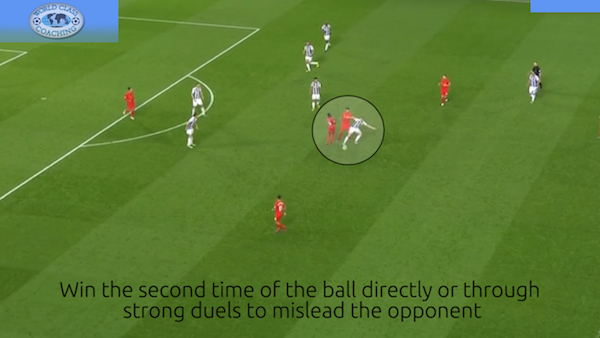
Liverpool is now in numerical advantage inside an available space to organize a fast attacking move (2 v 1); even if there's a general 3 v 5 + goalkeeper outnumbered situation, there's much space between the defenders and between themselves and every single player of Liverpool.
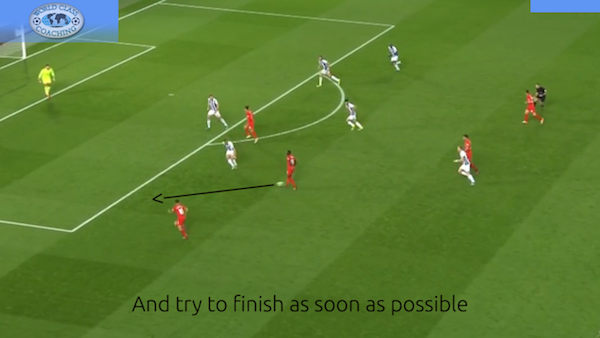
The positional or quality advantages to finish are just the consequence of defenders on late and of wrong marking actions.
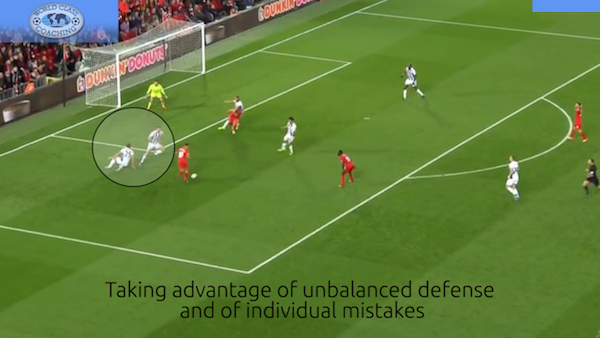
The second times of the ball are another one of the main goals of the high pressure; above all if they are won in the final third and near the penalty area. This is a responsibility of the attacking minded center midfielder. To win the defensive second times is a responsibility of the defensive midfielder. If it's not the center midfielder the player who attacks the ball inside that kind of situation, it's always an advanced one.
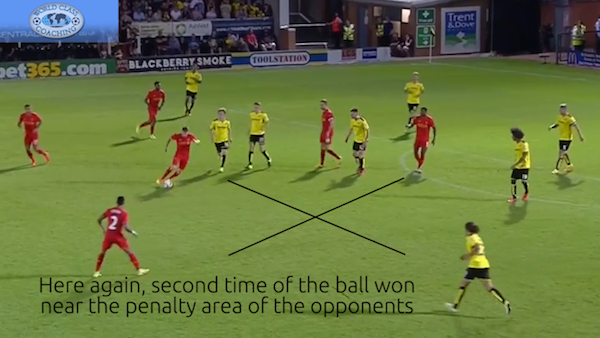
Fast pass combinations to finish quickly are allowed now; this is the reason why they are so important. In many of the moves, the advanced player who wins the second time of the ball is the one who tries to finish, attacking the goal vertically and receiving the decisive last pass behind the defense line.
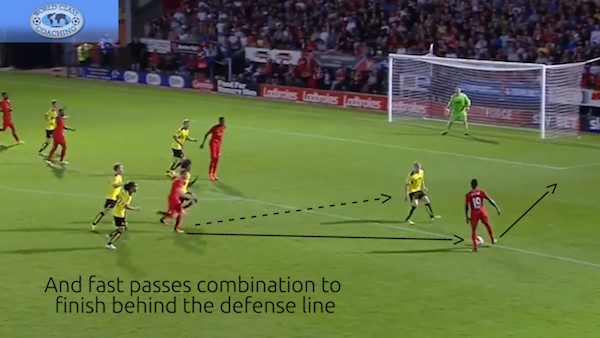
When the high pressure doesn’t allow recovery of the ball inside the final third, or at least inside the opponent’s half, the reaction speed to win the wandering balls in the middle third becomes very important; and Liverpool is very confident with it like Klopp’s Dortmund was.
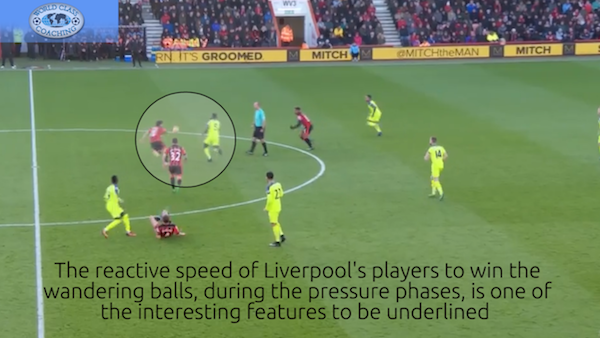
The same basic speed is always present during the possession phases, when the ball is gained back, and when the positive transition phase is organized to attack.
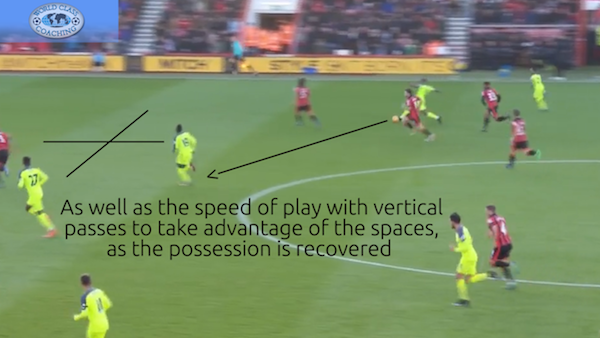
If the defenders are able to rebound a first vertical pass, to win the second times of the ball becomes very important. As the pressure inside the opposition half field is always strong, this kind of ball is often easily gained back.
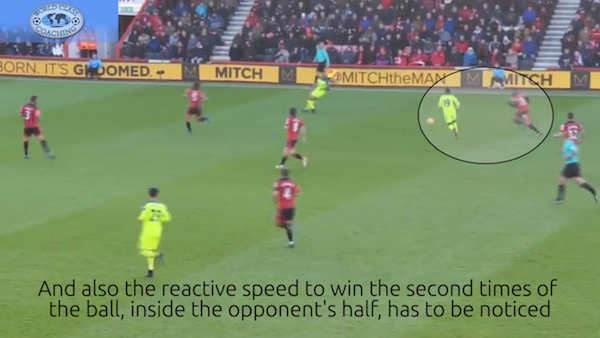
One of the center midfielders always supports the attacking move in the final stage; he's often placed just outside the penalty area, to shoot through the space created, if the defense line is placed too deep in the final third, or to take advantage of the eventual rebounds of the defenders or of the goalkeeper.
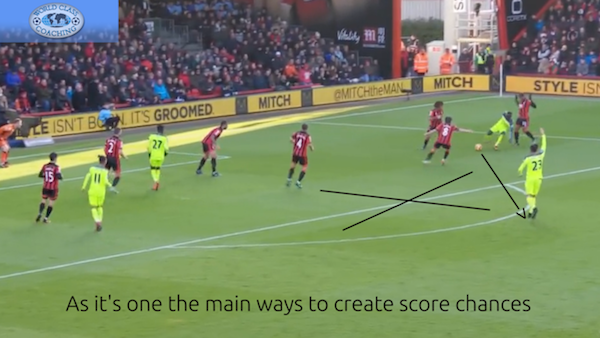
This move is an interesting example of "ball-oriented pressure.” Each player tries to anticipate the direct opponent who could take the control of the ball after long passes, always looking toward the opposition goal.
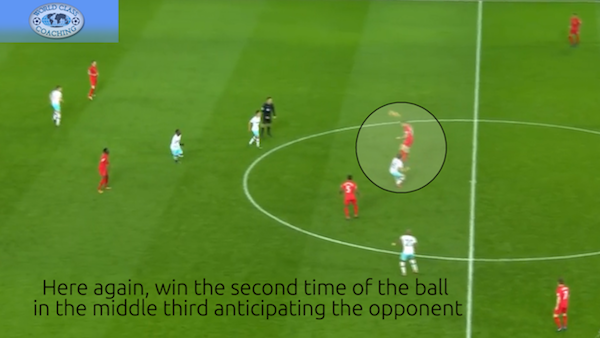
The wandering balls are attacked in the same way if the possession can’t be ensured after a first 1 v 1 duel. If there's a risk the ball can be won by the opponents, the pressure becomes "border-oriented" and the ball carrier is closed toward the sidelines.
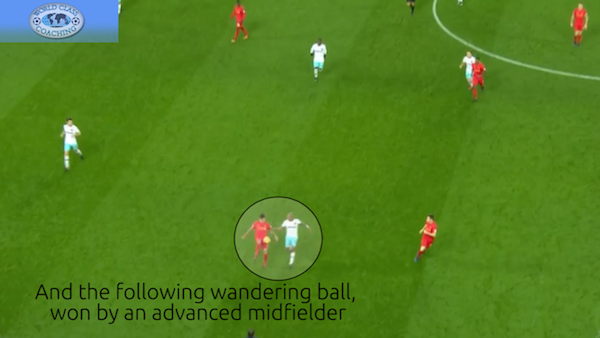
If the possession is gained after those duels and it's safer, vertical passes are now played through the available spaces.
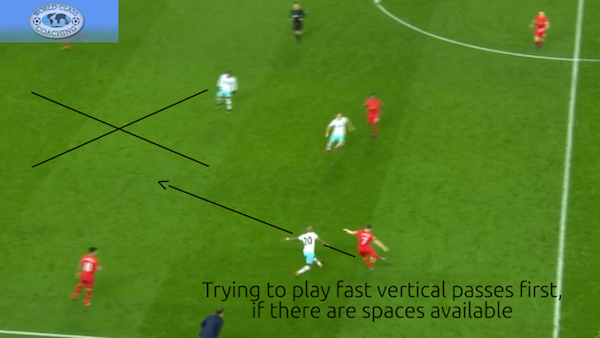
And, again, the moves are finished behind the opponent’s defense line, taking advantage of a better placement in the center 1 v 2 + goalkeeper duel, and of the wrong body placement of the defender near the ball (both are in a frontal position, they don't direct the forward toward the side lines and they leave space for a center pass).
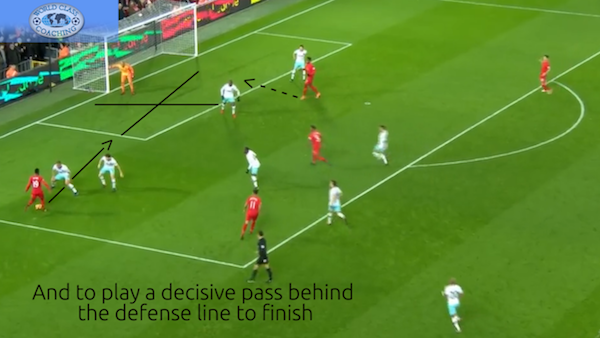
The moves are usually played with the fewest number of passes possible; once the move is near the goal area, they always try to finish without coming back to build up again.
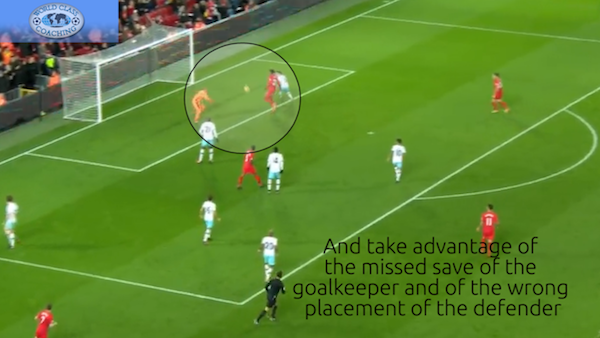
The prevention of the negative transitions is another of the goals of high pressure, of the strong attacks to the second times of the ball, and of the wandering balls inside the attacking half. Klopp's teams don't contemplate a classic pivot or play maker in the middle third, and both the center midfielders prefer to play with direct forward or diagonal passes. The players with best technique, dribbling and passing skills are placed in the line of three behind the center forward. This is the reason why they need to play side by side high on the field rather than build from the back.
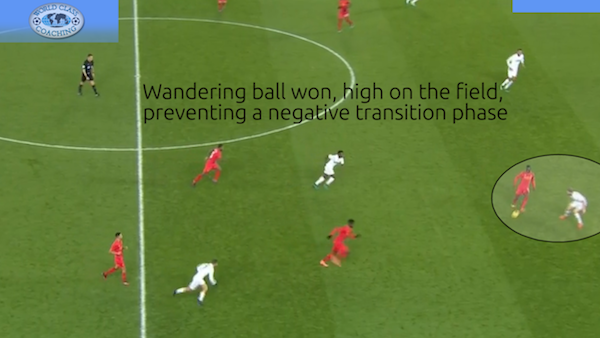
The space between the lines is one of the key factors in the attacking phase of Liverpool. The chance to build up fast attacking moves inside the opponent’s half, breaking the defense lines and unbalancing it with passes combinations, is always preferred. If the negative transitions are not fast and don't bring the team to win the ball back, these kind of moves are hard to be carried out.
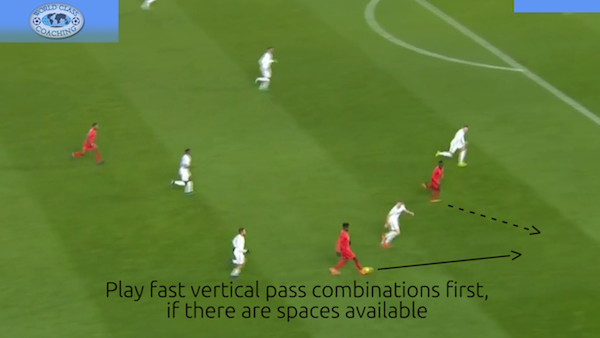
The forwards try always to cut off the opposition both playing the passes and running without the ball between the defenders, during the final stage of the attack.

These combinations allow creating the spaces to dribble through and to unbalance the defenders before the final stage of the attacks.
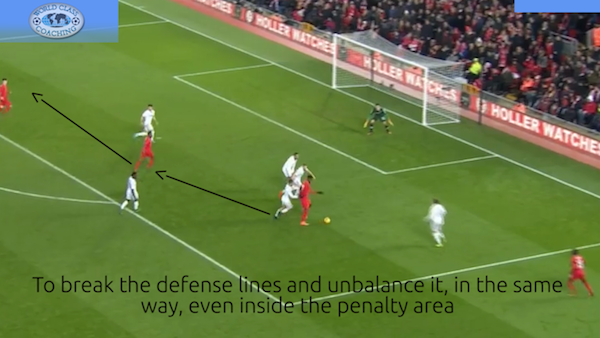
When Liverpool has to keep and manage the possession of the ball inside the middle third, because of the pressure of the opposition, which avoids its direct attacking play, they create high density near the ball and a strong side on the field. They play 1 v 1 duels not to lose the space and to have more chances to win the second times and the wandering balls. This is another different way of pressure and of potential "team-oriented" counter-pressing.
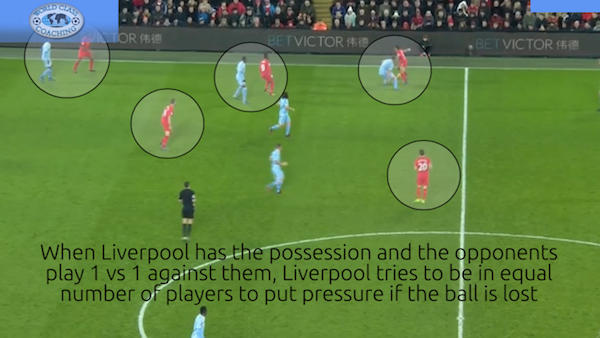
If the possession is lost temporarily, the basic idea is not to run back to save the deep spaces of the field, but to stay high, to play individual duels to win the ball and to have the chance to attack, starting from the middle or the final third. This is the main goal of a team-oriented counter-pressing.
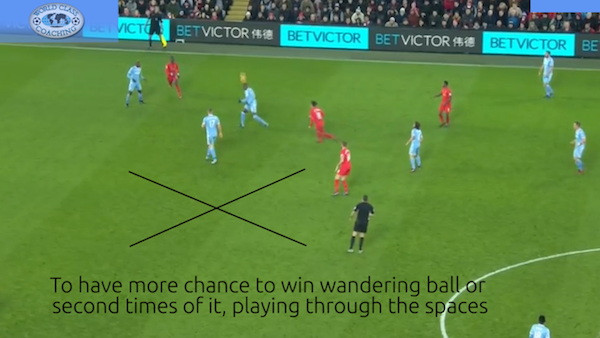
The split of the pitch to build the moves, as the possession is recovered, is very interesting to notice. The goal is not to build up through the weak side of the opponents, but to find a 3rd man who's running inside from there without the ball. This move has been built up in the same strong side of the prior duels, and the weak side is free to be used to finish.
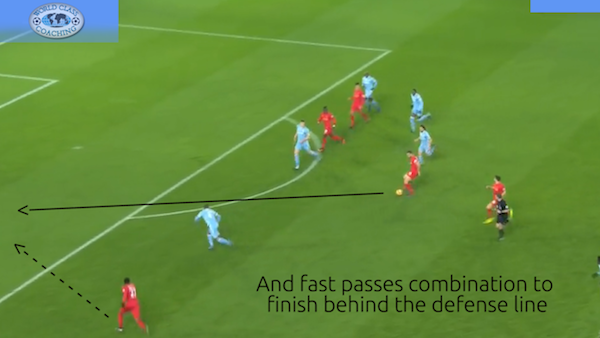
This is another way to be in positional advantage inside the penalty area; 1 v 1 with the defender on late near the ball and a 1 v 2 + goalkeeper duel near the goal with the center forward who can run between the center backs.
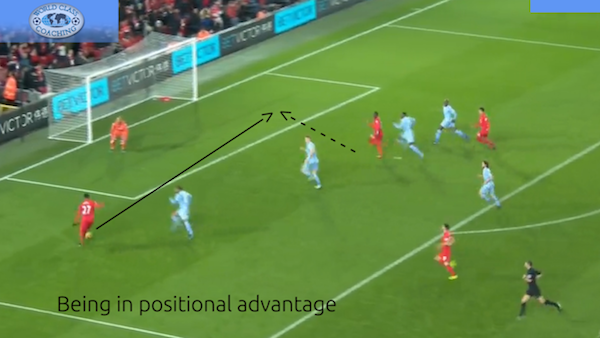
When the opponents are pressing 1 v 1 inside the strong side, even if there's not a high zonal density of player as in the prior situation, they stay placed there to win the wandering balls...
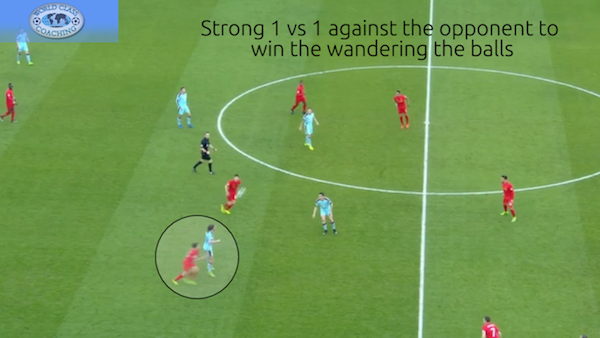
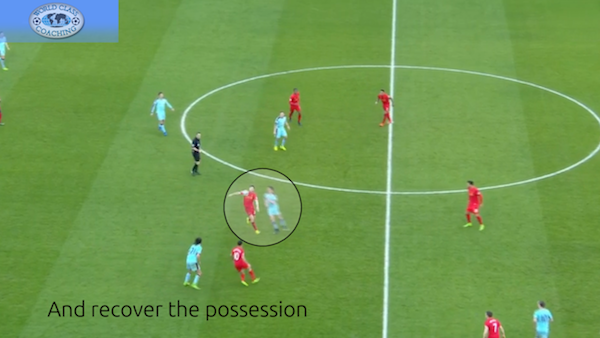
...trying to switch the side of play to finish thanks to the following positional and numerical advantage. As the possession is won back, Liverpool's attacking phase is developed looking to play toward the goal's space, both dribbling the ball and with up and down passing combinations.
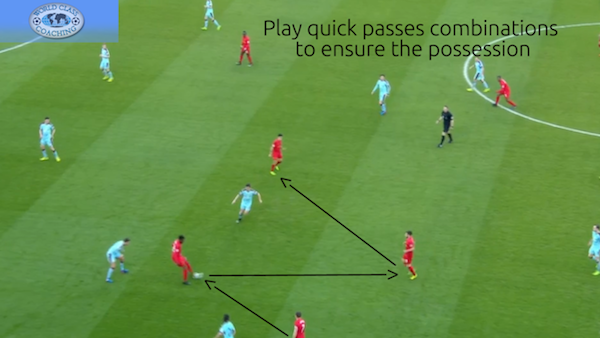
If the spaces are closed or if they are outnumbered because the defenders recovered the space, then they play wide passes first...
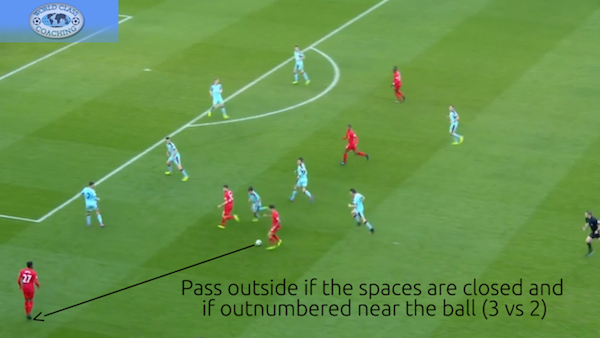
...and then cross passes to attack the goal. In this situation, the defender leaves the space for a cross pass, placing himself over the ball line, while he's marking.
